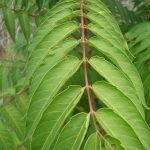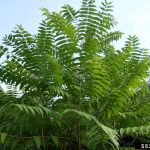Tree of Heaven
Identification:
Smooth stems with pale gray bark and twigs which are light chestnut brown, especially in the dormant season. Its large compound leaves are 1-4 feet in length, alternate, and composed of 10-41 smaller leaflets. Flowers occur in large terminal clusters and are small and pale yellow to greenish. They have flat, twisted, winged fruits each containing a single central seed remaining on the tree from late summer to early fall. It is important not to confuse native shrubs and trees with tree of heaven. Native sumacs and trees like ash, hickory, black walnut, and butternut can be distinguished from tree-of-heaven by having completely serrated (toothed) leaf margins. Additionally, tree of heaven leaves give off a scent similar to peanut butter when crushed.
Tree of heaven is a sexually dimorphic plant, having distinct male and female individuals. It reproduces both sexually (by seeds) and asexually through vegetative sprouting. Flowering occurs late in the spring. It both grows and reproduces at a very fast rate allowing it to push out native species and create large thickets. It has the ability to poison root systems and damage sewer lines with its roots.
Control:
Hand pulling is acceptable for small saplings of this species, with mechanical removal and a “cut-and-dab” chemical treatment needed for larger trees. Make sure to bag all limbs that may contain seed pods to prevent the spread of the plant. If the trunk is cut without root removal or chemical treatment it will regrow with increase veracity, sending up multiple new trunks from the cut stump.



